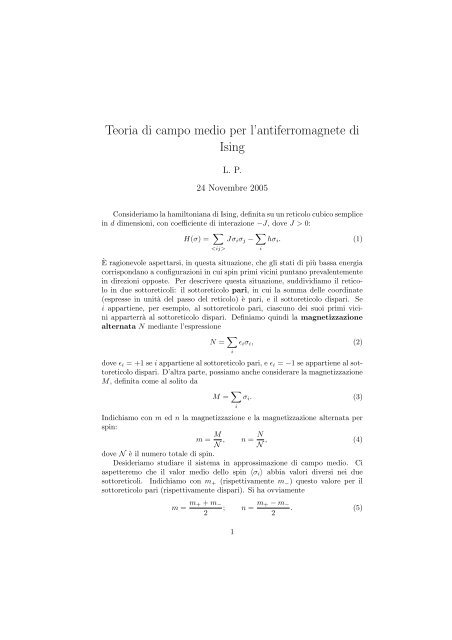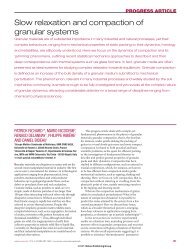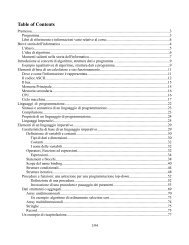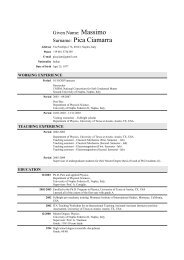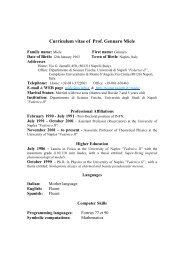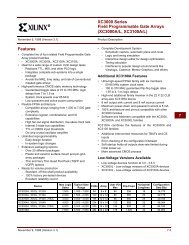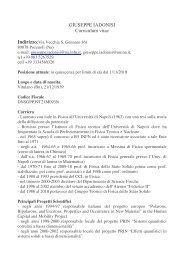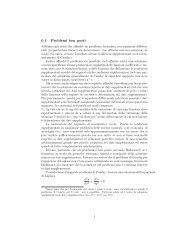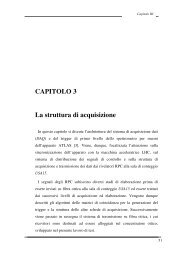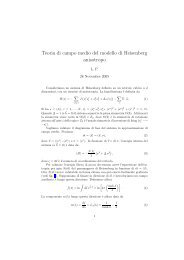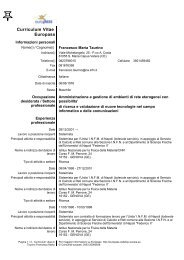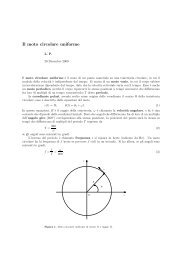Teoria di campo medio per l'antiferromagnete di Ising
Teoria di campo medio per l'antiferromagnete di Ising
Teoria di campo medio per l'antiferromagnete di Ising
Create successful ePaper yourself
Turn your PDF publications into a flip-book with our unique Google optimized e-Paper software.
<strong>Teoria</strong> <strong>di</strong> <strong>campo</strong> me<strong>di</strong>o <strong>per</strong> l’antiferromagnete <strong>di</strong><br />
<strong>Ising</strong><br />
L. P.<br />
24 Novembre 2005<br />
Consideriamo la hamiltoniana <strong>di</strong> <strong>Ising</strong>, definita su un reticolo cubico semplice<br />
in d <strong>di</strong>mensioni, con coefficiente <strong>di</strong> interazione −J, dove J > 0:<br />
H(σ) = <br />
Jσiσj − <br />
hσi. (1)<br />
<br />
È ragionevole aspettarsi, in questa situazione, che gli stati <strong>di</strong> più bassa energia<br />
corrispondano a configurazioni in cui spin primi vicini puntano prevalentemente<br />
in <strong>di</strong>rezioni opposte. Per descrivere questa situazione, sud<strong>di</strong>vi<strong>di</strong>amo il reticolo<br />
in due sottoreticoli: il sottoreticolo pari, in cui la somma delle coor<strong>di</strong>nate<br />
(espresse in unità del passo del reticolo) è pari, e il sottoreticolo <strong>di</strong>spari. Se<br />
i appartiene, <strong>per</strong> esempio, al sottoreticolo pari, ciascuno dei suoi primi vicini<br />
apparterrà al sottoreticolo <strong>di</strong>spari. Definiamo quin<strong>di</strong> la magnetizzazione<br />
alternata N me<strong>di</strong>ante l’espressione<br />
N = <br />
ǫiσi, (2)<br />
i<br />
dove ǫi = +1 se i appartiene al sottoreticolo pari, e ǫi = −1 se appartiene al sottoreticolo<br />
<strong>di</strong>spari. D’altra parte, possiamo anche considerare la magnetizzazione<br />
M, definita come al solito da<br />
M = <br />
σi. (3)<br />
In<strong>di</strong>chiamo con m ed n la magnetizzazione e la magnetizzazione alternata <strong>per</strong><br />
spin:<br />
m = M N<br />
, n = , (4)<br />
N N<br />
dove N è il numero totale <strong>di</strong> spin.<br />
Desideriamo stu<strong>di</strong>are il sistema in approssimazione <strong>di</strong> <strong>campo</strong> me<strong>di</strong>o. Ci<br />
aspetteremo che il valor me<strong>di</strong>o dello spin 〈σi〉 abbia valori <strong>di</strong>versi nei due<br />
sottoreticoli. In<strong>di</strong>chiamo con m+ (rispettivamente m−) questo valore <strong>per</strong> il<br />
sottoreticolo pari (rispettivamente <strong>di</strong>spari). Si ha ovviamente<br />
m = m+ + m−<br />
2<br />
i<br />
i<br />
; n = m+ − m−<br />
. (5)<br />
2<br />
1
Quin<strong>di</strong><br />
m+ = m + n; m− = m − n. (6)<br />
Possiamo adesso valutare l’entropia S0 che compare nell’espressione dell’energia<br />
libera <strong>di</strong> prova nella teoria <strong>di</strong> <strong>campo</strong> me<strong>di</strong>o. Avremo N/2 spin con magnetizzazione<br />
m+ e altrettanti con magnetizzazione m−. L’entropia <strong>per</strong> spin <strong>di</strong> un<br />
paramagnete con magnetizzazione x è data da<br />
Quin<strong>di</strong><br />
s(x) = −kB<br />
1 + x<br />
2<br />
<br />
log<br />
1 + x<br />
2<br />
<br />
+<br />
1 − x<br />
2<br />
<br />
log<br />
1 − x<br />
2<br />
<br />
. (7)<br />
S0 = N<br />
2 [s(m+) + s(m−)] = N<br />
[s(m + n) + s(m − n)] .<br />
2<br />
(8)<br />
L’energia libera <strong>di</strong> prova, espressa in funzione <strong>di</strong> m ed n, è quin<strong>di</strong> data da<br />
<br />
F(m,n) = N − ζJn2<br />
<br />
T<br />
− hm − [s(m + n) + s(m − n)] ,<br />
2 2<br />
(9)<br />
dove ζ = 2d è il numero <strong>di</strong> coor<strong>di</strong>nazione del reticolo. Ricordando che<br />
ds<br />
dx = −kB tanh −1 x, (10)<br />
possiamo ottenere le equazioni <strong>di</strong> autoconsistenza <strong>per</strong> m ed n:<br />
h = kBT<br />
2<br />
ζJn = kBT<br />
2<br />
tanh −1 (m + n) + tanh −1 (m − n) ; (11)<br />
tanh −1 (m + n) − tanh −1 (m − n) . (12)<br />
Evidentemente queste equazioni ammettono sempre la soluzione banale con n =<br />
0 e con<br />
<br />
h<br />
m = tanh .<br />
kBT<br />
(13)<br />
Ve<strong>di</strong>amo in quali con<strong>di</strong>zioni è possibile ottenere delle soluzioni stabili con n = 0.<br />
Poiché<br />
tanh(m + n) = tanh(m) +<br />
otteniamo<br />
n mn2<br />
+<br />
1 − m2 (1 − m2 ) 2 + (1 + m2 ) 2n3 3(1 − m2 ) 3 + o(n3 ), (14)<br />
1 −1 −1 n<br />
tanh (m + n) − tanh (m − n) =<br />
2<br />
1 − m2 + (1 + m2 ) 2n3 3(1 − m2 ) 3 + o(n3 ). (15)<br />
Quin<strong>di</strong>, <strong>per</strong> piccoli valori <strong>di</strong> n, otteniamo l’equazione<br />
ζJ<br />
kBT −<br />
1<br />
1 − m 2<br />
<br />
n ≃ (1 + m2 ) 2n3 3(1 − m2 . (16)<br />
) 3<br />
2
Questa equazione ammette soluzioni con n reale solo se il fattore fra parentesi<br />
a primo membro è positivo. Abbiamo quin<strong>di</strong> identificato la linea <strong>di</strong> transizione<br />
Tc(m) in funzione della magnetizzazione <strong>per</strong> spin m:<br />
kBTc(m) = (1 − m 2 )ζJ. (17)<br />
Ve<strong>di</strong>amo che, <strong>per</strong> m = 0, la tem<strong>per</strong>atura critica è uguale a quella del modello<br />
<strong>di</strong> <strong>Ising</strong> ferromagnetico. Però, all’aumentare <strong>di</strong> |m|, la tem<strong>per</strong>atura tende a<br />
0. È anche interessante considerare la linea <strong>di</strong> transizione Tc(h) in funzione<br />
del <strong>campo</strong> magnetico applicato h. Poiché m, h e T sono collegati dalla (13),<br />
dobbiamo risolvere la seguente equazione in Tc:<br />
kBTc = 1 − tanh 2 (h/kBTc) ζJ. (18)<br />
In realtà è molto più semplice esprimere parametricamente Tc(m) tramite la<br />
(17) e h(Tc,m) invertendo la (13). Si ottiene così il <strong>di</strong>agramma <strong>di</strong> fase mostrato<br />
in figura 1, in cui gli stati con n = 0 sono all’interno della curva, e le tem<strong>per</strong>ature<br />
sono misurate in unità Tc(0). Notiamo che, se h = 0, c’è una regione in cui si ha<br />
1<br />
0.8<br />
0.6<br />
0.4<br />
0.2<br />
T<br />
-0.4 -0.2 0.2 0.4<br />
Figura 1: Diagramma <strong>di</strong> fase <strong>per</strong> l’antiferromagnete <strong>di</strong> <strong>Ising</strong> nel piano (h,T).<br />
La fase antiferromagnetica è all’interno della curva.<br />
un comportamento rientrante della fase antiferromagnetica: si passa dalla fase<br />
<strong>di</strong>sor<strong>di</strong>nata alla fase antiferromagnetica abbassando la tem<strong>per</strong>atura al <strong>di</strong>sotto <strong>di</strong><br />
una tem<strong>per</strong>atura Tc1; poi <strong>per</strong>ò, a una tem<strong>per</strong>atura Tc2 < Tc1, il sistema ritorna<br />
nella fase <strong>di</strong>sor<strong>di</strong>nata.<br />
Notiamo che l’andamento della suscettività χ = ∂m/∂h cambia quando n<br />
<strong>di</strong>venta non nullo. <strong>per</strong> piccoli valori <strong>di</strong> |n|, abbiamo infatti dalla (11), tenendo<br />
conto della (14),<br />
h ≃ kBT<br />
<br />
tanh(m) + mn2<br />
(1 − m2 ) 2<br />
<br />
. (19)<br />
3<br />
h
χ<br />
1<br />
0.8<br />
0.6<br />
0.4<br />
0.2<br />
0.5 1 1.5 2<br />
Figura 2: Suscettività magnetica χ = ∂m/∂h in funzione <strong>di</strong> T, lungo la linea<br />
h = 0. La tem<strong>per</strong>atura è misurata in unità <strong>di</strong> Tc.<br />
Il secondo termine <strong>di</strong> questa equazione è proporzionale a m[Tc(m) − T] (con un<br />
coefficiente positivo). Quin<strong>di</strong> la derivata <strong>di</strong> χ rispetto a T subisce una <strong>di</strong>scontinuità<br />
<strong>per</strong> T = Tc. Per esempio, in figura 2 viene mostrata la suscettività in<br />
funzione <strong>di</strong> T lungo la linea h = 0. In questo caso, è facile vedere che<br />
χ =<br />
1 − n2<br />
. (20)<br />
kBT<br />
4<br />
T


